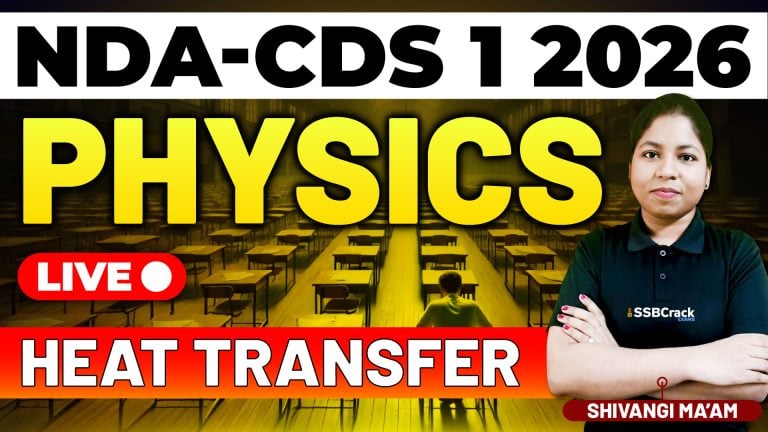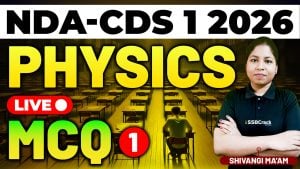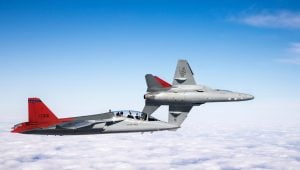In the preparation journey for competitive exams like the National Defence Academy and Naval Academy (NDA-NA) Exam – Paper II – General Ability Test (GAT) and the General Knowledge (GK) Paper of the Combined Defence Services (CDS) Exam, mastering Physics concepts is critical. Among these, the topic of Reflection of Light is not only scoring but also frequently tested.
A recent class on Reflection of Light was dedicated to practicing multiple-choice questions (MCQs). The questions included both those from previous years’ papers and expected ones, following the exam pattern. This blog discusses the details of the class, the significance of this practice, and strategies to prepare the topic effectively for the NDA-NA and CDS exams.
Highlights of the Class
1. Focus on Previous Years’ Questions
The class began with solving MCQs that have appeared in past NDA-NA and CDS exams. These questions served as a guide to understand:
- The depth of knowledge required for the topic.
- Commonly tested sub-topics such as plane mirrors, spherical mirrors, and laws of reflection.
Practicing these questions provided students with insights into the question patterns and how concepts are framed in the actual exam.
2. Expected Questions Based on Exam Trends
After solving past questions, the focus shifted to expected MCQs. These were designed based on:
- Current trends in the exam.
- Application-based and conceptual questions, such as identifying the type of mirror used in a specific scenario or analyzing the characteristics of images formed.
Students were encouraged to solve these questions within a time limit to simulate exam conditions.
3. Comprehensive Coverage of Sub-Topics
The class ensured that all critical sub-topics under Reflection of Light were covered, including:
- Plane Mirrors: Questions focused on image characteristics like lateral inversion, erect and virtual nature, and applications.
- Spherical Mirrors: Concave and convex mirrors were explored through questions on their uses, principal focus, and image formation.
- Laws of Reflection: Fundamental questions were included to reinforce these basic principles.
- Sign Convention and Magnification: MCQs tested students’ ability to apply the sign convention effectively and determine the size and nature of images.
4. Problem-Solving Techniques
Students were taught techniques to solve questions efficiently, such as:
- Drawing rough ray diagrams to visualize image formation.
- Eliminating incorrect options using logical reasoning.
- Identifying keywords in the question to understand its core requirement.
5. Discussion of Common Mistakes
The class also emphasized avoiding common errors, such as:
- Misinterpreting the sign convention.
- Confusing the properties of concave and convex mirrors.
- Overlooking details in the question stem that could lead to incorrect answers.
Strategies to Prepare Reflection of Light for NDA-NA and CDS Exams
1. Start with the Basics
Ensure a strong understanding of the foundational concepts, including:
- Laws of reflection.
- Types of mirrors and their image-forming properties.
- Real-world applications of mirrors.
2. Practice MCQs Regularly
Practicing questions is the most effective way to prepare. Focus on:
- Previous years’ question papers to understand the types of questions asked.
- Mock tests and sample papers to identify your strengths and weaknesses.
3. Master Ray Diagrams
Ray diagrams are essential for understanding image formation. Practice drawing diagrams for different positions of objects relative to the mirror. This will help you answer both conceptual and numerical questions with confidence.
4. Develop a Strategy for Sign Convention
The sign convention can be tricky, but it is crucial for solving problems related to spherical mirrors. Create a reference chart to keep track of when distances are positive or negative. Practice applying this convention until it becomes second nature.
5. Time Management
Time is of the essence in competitive exams. While solving MCQs:
- Set a timer to practice solving questions quickly.
- Focus on accuracy to avoid negative marking.
6. Revise Regularly
Make revision a habit. Use concise notes that summarize key points, such as the characteristics of images formed by mirrors, the applications of concave and convex mirrors, and problem-solving tips.
7. Strengthen Problem-Solving Skills
Learn to approach questions systematically:
- Read the question carefully to understand its requirements.
- Use elimination techniques to narrow down options.
- Draw a diagram or outline the problem if needed for clarity.
Conclusion
The recent class on Reflection of Light was a productive session that combined theoretical understanding with practical application through MCQs. It emphasized the importance of solving previous years’ questions and tackling expected ones to build familiarity with the exam pattern.
To excel in this topic, focus on building conceptual clarity, practicing regularly, and mastering techniques like ray diagrams and the sign convention. With consistent effort and a structured approach, Reflection of Light can become one of the most scoring sections of the Physics syllabus for the NDA-NA and CDS exams.
Stay disciplined, practice diligently, and keep revising. Success in these competitive exams is within reach!

















